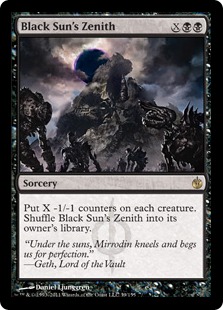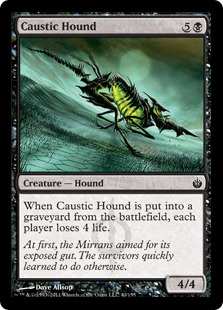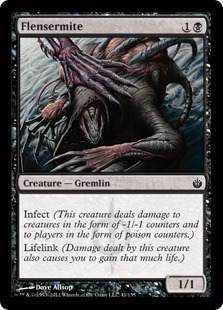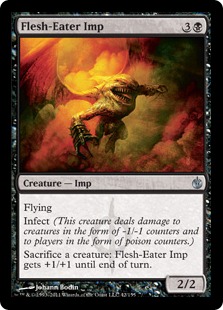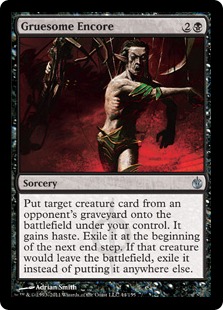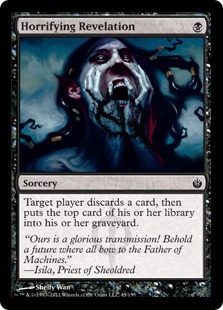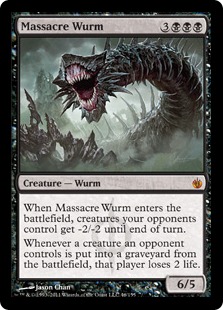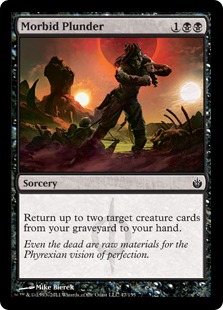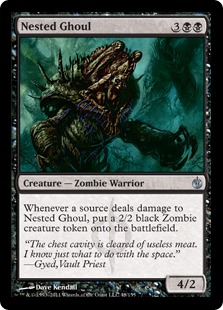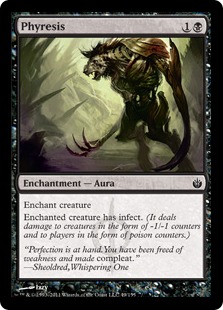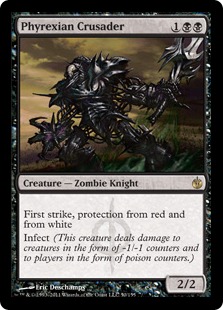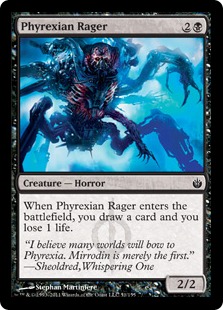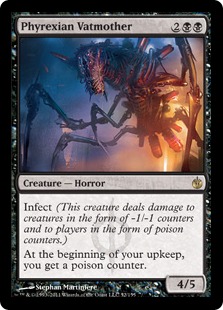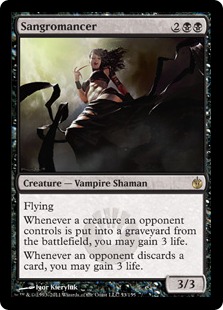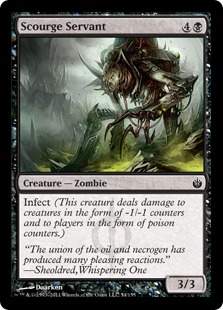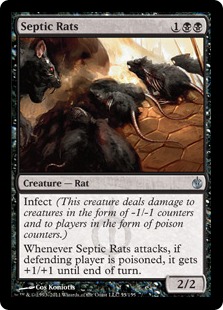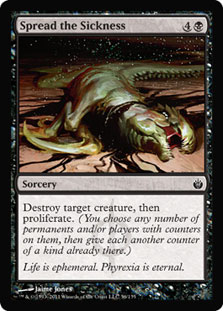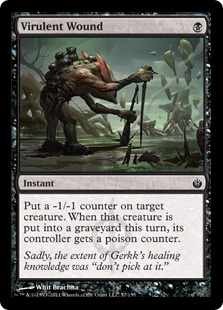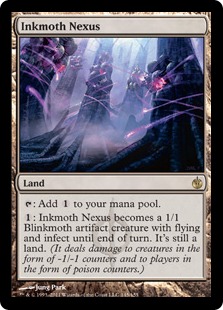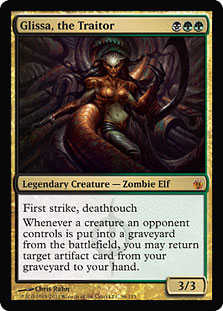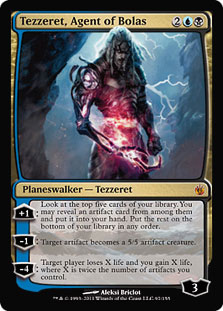Mirrodin Besieged? A very apt name to be sure. The war between the Mirrodin natives (the, ahem, Mirrans) and the Phyrexians is playing out in
a very clear and evocative manner.Â
Most of the black cards are Phyrexian, as are most of the green cards. Most of the red cards are Mirran, as are most of the white cards. Blue is
basically split down the middle, as are artifacts.
Seeing as how we’ll basically never see faction packs again, this probably doesn’t have a ton of game functionality, though it’s interesting to
consider the implications of faction packs and their uniqueness. Some players have expressed annoyance at the prospect of walking away from the
Prerelease with faction packs instead of regular boosters, as they just want to do regular drafts. Ironically, these same packs, which they would be
all too happy to trade away, may someday fetch a premium from those looking to draft an exotic format using hard-to-find packs. The fact that these
boosters will only be available for one weekend implies a level of scarcity; however, the contents are still just Mirrodin Besieged, not Portal Three
Kingdoms or anything, so personally, I’d be more than happy to bust them.
As this article is posted, I’ll be three-quarters of the way over the Atlantic Ocean on my way to Paris to meet with Gabriel Nassif, Guillaume
Wafo-Tapa, Guillaume Matignon, Michael Jacob, and others to prepare for Pro Tour Paris.
We discussed how to prepare for the draft portion of the event, as we’ll have only faction packs for the first five days of testing.
The solution? We’ll just open them facedown, making piles of the rares/mythics, the uncommons, and the commons (with foils getting pulled, as they will
be at the Pro Tour). Then, after shuffling, we randomly produce boosters. This isn’t an ideal scenario, as it’s possible that there are pronounced
print runs in the regular boosters that won’t appear in our generated ones; however, this is surely a fine fix considering the extremely limited amount
of time we have to test for this event.
Those five extra days of drafting will be five days that relatively few other players will take advantage of. It’s always interesting to prepare for
Limited events that aren’t yet available on Magic Online, as the draft technology evolves at glacial speeds, comparatively.
Today, we’re going to focus on the black, land, and gold cards from Mirrodin Besieged. As always, I’ll focus primarily on potential applications for
new cards, rather than using some arbitrary rating system. All too often people assign some 1-10 or 1-5 rating to cards as though Magic were some game
where you just want to figure out which are the 4’s and 5’s, make a pile of those, and then call it a day.
That isn’t Magic! The cards mean nothing without context! Are some cards going to be intrinsically stronger than others (generally by creating more
good for less cost)? Absolutely, but it’s such a trivial exercise compared to the exercise of determining exactly how to use these cards, properly. We
don’t want to know just about where we end up; we want to know about everywhere.
For instance, look at Spellstutter Sprite and Mistbind Clique. The “rating” those cards would’ve received would’ve been comical compared to how strong
we know them to be today. The printing of Bitterblossom radically changed the landscape for those cards, so any previous rating on their power level
would’ve become worthless. What good would it have done readers to read an article that said, “Spellstutter might be okay in Legacy, where spells are
cheap”? “Mistbind Clique is cute, but all the Faeries suck”?
Guess what; there are always going to be more cards printed that change the contextual values. Prismatic Omens wasn’t always a $15 tournament staple!
Instead, a discussion about what it takes or would take to use Spellstutter Sprite and Mistbind Clique would be far more valuable. We could be one of
those few pioneering Faeries decks, like Zvi’s Mono-Blue version or the U/G version that some players tried to use back in late 2007. We could be
discussing things like how a Faerie token generator would let us make Spellstutter Sprite a hard counter or how having a Faerie that doesn’t easily die
to removal would flip the switch on Mistbind Clique. Then, when Bitterblossom is printed and starts out as a $5 rare, we could be snatching up dozens
of copies on Prerelease weekend and during the first week of the set’s release. Want to see the future? Â
Instead of trying to force the new pegs into the holes of yesterday, imagine what holes would have to exist in order for these pegs to fit!
Let’s start with the black cards:
Black
Well, we’re not messing around! Cutting straight to the chase, we have the latest black sweeper, a card sure to get a fair bit of the spotlight, even
if it’s just because of how obvious the card is. This isn’t to say that the card is obviously good or anything, just that its applications are obvious,
making it an easy card for people to wrap their minds around.
In the market for an Infest? For just a mana more, you get Infest, but it permanently shrinks creatures that were too large to kill. Additionally, it
shuffles back into your library, giving you more chances to draw it later (and as an X-spell, its power grows over time), and sometimes a free shuffle
is worth paying for (yet another card that makes Jace, the Mind Sculptor better…).
Still, there’s one more extremely important feature to Black Sun’s Zenith: You don’t have to do it for two. Often, hitting one-toughness creatures is
all that’s needed, letting you save a mana. Still other times, we’ll need to actually sweep the board, including our opponent’s Thrun, the Last Troll.
Here, being able to scale up becomes very important. Basically, Black Sun’s Zenith is always just a little bit expensive, but black is a color that has
always appreciated Day of Judgment-type effects more than white.
Verdict? Because of how expensive it is to wield, many people will probably have too many copies of this card in decks that should actually only have
one or two. Still, it’s a fine sweeper, assuming the context is right, that will see both maindeck and sideboard play.
What makes the context right? Well, first of all, we have to be in the market for a black sweeper at all. If every blue deck plays white or red, this
is less relevant. Alternatively, if every black deck uses tons of creatures, this is less appealing. Next, even if we want a sweeper, we have to want
this more than cards like Consume the Meek and Ratchet Bomb. Consume the Meek is much less reliable, but being instant speed might be ideal in a world
where people play cards like White Sun’s Zenith.
Wafo, Matignon, and I discussed this card a bit in Atlanta, and at first glance, we think it might have a slight edge over Consume the Meek on power,
as the reliability, reshuffle, and ability to shrink guys it doesn’t outright kill give it a lot of play. Overall, it’s nowhere near Damnation, or even
Mutilate, but it’s a solid role player that will become a regular tool for helping Black Mages combat creature swarms. Perhaps I have an unnatural love
for thinking about mono-black decks, but Black Sun’s Zenith is particularly important as a sweeper in such a deck.
One last, interesting feature to consider is the use of -1/-1 counters instead of shrinking until end of turn or damage, which is more common.
Obviously, this interacts with proliferate, but this also creates weird side effects with cards that let you remove -1/-1 counters for some gain
— or even better, cards that key off of -1/-1 counter use. Consider casting Necroskitter on turn 3, then following up with a Black Sun’s Zenith.
Necroskitter easily lives, but now instead of sweeping your opponent’s board, you’ve actually stolen it! Â
Dusk Urchin actually combines with Black Sun’s Zenith to form a Mind Spring! In fact, basically all of Shadowmoor and Eventide should be reevaluated in
a new light, as -1/-1 counters are easier than ever to come by. Additionally, Black Sun’s Zenith is particularly effective against creatures like
Kitchen Finks, while interacting strangely with creatures like Carnifex Demon. The moral of the story? Using a label, like “Black Sweeper,” only goes
so far and can actually cause us to overlook other important elements of a card if we’re not mindful (such as “source of -1/-1 counters”).
Now swinging to the other end of the spectrum, we have a card that’s painfully obviously (probably) never going to be a Constructed card.
Wait! What’s this? How am I so sure that this card isn’t a Constructed card? How do I know this isn’t the next Necropotence?
Simple, what are the unique features of Caustic Hound? When a card is just a worse something else, it’s the single best way to be able to write it off.
In this case, Caustic Hound’s body of 4/4 for six is miles away from the industry standard 6/6 for six. Then, as for his abilities, compare him to
Grave Titan. Instead of automatically getting two 2/2s a turn, we have a conditional death trigger that makes each player lose four life! In fact, I’d
be hard pressed to play Caustic Hound at 2B, let alone 5B.
What are the upsides? Well, it’s slightly easier to cast than Grave Titan, sure, but it’s main “advantage” is that it’s a Hound. Why does this
matter? Well, right now, it doesn’t really. Giants and Zombies have some support, but there are not a ton of Hound lords. Still, what if a future set
contained the followed card:
Lauer, Keeper of a Hound  B
Creature – Human Wizard
When Lauer, Keeper of a Hound enters the battlefield, you may search your library for a Hound card and put it onto the battlefield. Then, destroy all
Cats.
1/1
Obviously this is a bit of a silly card, but if such a card were printed, we would have a potentially Legacy-strong reason to want to play Caustic
Hound in our deck. The line about destroying all Cats seems like a bit of a joke, but if it were not for that line, we would surely find many
changelings to be far superior “Hounds” than Caustic Hound. I predict, however, that we do not see Lauer, Keeper of a Hound in a black-bordered set in
our lifetimes.
Scars of Mirrodin gave us four options for two-drop infect creatures, and many strategies would only play three. Still, the primary reason each of them
has been used is simply on account of being a two-drop infect creature. Now, we also have Flensermite and Plague Myr to choose from, both with their
advantages. Flensermite’s lifelink is an interesting ability to consider because many of the best things to do with infect creatures actually work
especially well with lifelink. For instance, cards like Adventuring Gear, which amount to a double bonus on infect creatures, also provide a bonus on
lifelink creatures. If a Giant Growth does the equivalent of six on an infect creature, it also gains three on Flensermite, which is pretty incredible
for racing.
That said, infect strategies are often among the most aggressive, meaning they’re often not in the market for life gain. Personally, I’m much more
excited for Plague Myr than Flensermite, but he’s a very worthwhile consideration, especially if we anticipate having to do some racing. He also works
particularly well with equipment and auras, but then again, what infect creature doesn’t? Also, definitely one of the two best pure Gremlins in the
game’s history…
I love infect on fliers, and Flesh-Eater Imp also has a cute bonus ability that works well with cards like Necropede and Core Prowler. While this card
is an absolute monster in Limited, he faces pretty stiff competition at the four-spot in Constructed. Both Hand of the Praetors and Phyrexian Vatmother
also cost four, not to mention Corpse Cur, making it unlikely that he sees much Constructed play. That said, he’s the best four-drop flying infect
creature, so if what you really want is all-evasion infect creatures, Flesh-Eater Imp is at least at a moderate power level and lets you do some pretty
cool tricks.
There’s an old R&D joke that every card would be more “interesting” if it had haste, cantripped, or cost one less. In reality, that’s code for
“everything seems like it would be more interesting if it were just better,” but this is one card in particular that has me fantasizing about what
could have been. I’m not saying Flesh-Eater Imp (or I) deserves it; I’m just saying if this guy had haste, it would be a very different world we live
in. Then again, the same is probably true of Leatherback Baloth…
What mix of creature removal should I play?
The game has totally changed. This is one of the most important cards, if not the most important card, in the set. This is such a
revolutionary card that the ripples from its printing will continue to be felt for quite some time to come. Why is GftT so important?
It’s the best black spot removal spell ever printed! This is as big of a deal as Path to Exile, in many regards. The best, cheap black removal
generally tends to have one of the following three weaknesses:
1. It can’t hit black creatures. Doom Blade is awesome, but Grave Titan, Creeping Tar Pit, and Vampires make this card a scary one to count on.
2. It can’t hit big creatures. Disfigure and Grasp of Darkness are awesome, but Titans, Baneslayers, and Gideon make these a bit unreliable.
3. It can’t hit the best creature when the opponent has an army. Diabolic Edict and Gatekeeper of Malakir are great cards, but you can’t always be sure
you’ll hit the creature you want, especially in a format like Standard, where opponents whom you want spot elimination against are likely to have
multiple creatures.
Go for the Throat totally changes the landscape. It’s the Doom Blade we always wanted, a Blade that actually kills Grave Titan, Tar Pit, and Vampires.
Its weakness? It doesn’t kill creatures like Lodestone Golem, Inkmoth Nexus, and artifacts animated by Tezzeret, Agent of Bolas. While that matters,
that’s generally going to matter less often and in matchups where it matters less. The result? Go for the Throat is going to be the default creature
kill spell of choice. Yes, it’s vital to have a playset of this card, in much the same way a playset of Paths to Exile is vital.
That’s just level one, however. Go for the Throat is so good it may be a bit of a victim of its own success. Since Go for the Throat will be
everywhere, it makes artifact creatures better across the board. This will have a subtle impact, incentivizing players to play more artifact creatures,
such as Wurmcoil Engine over a Titan or a Baneslayer. This could easily lead to a metagame where it’s right to play a mix of removal that may be
slanted towards GftT but not completely.
While this card will help shape the Standard format, it’s hardly contained in just one format. In Extended, this is the removal spell we’ve been
waiting for. Finally, a Doom Blade that kills both Mistbind Clique and Putrid Leech. While Grasp of Darkness has gained some popularity for this exact
reason, GftT is a major upgrade, also hitting Baneslayer, Primeval Titan, Wall of Reverence, Knight of the Reliquary, and more. A format staple to be
sure and going straight into Faeries, Five-Color Control (where it’s much easier to cast than Terminate), and more. In fact, it may be a little
expensive, but GftT will actually see a small amount of Legacy play. A Doom Blade that hits Dark Confidant has my interest, and while it’s actually a
little expensive for the format, it’s the best at what it does.
Ironically, it is Limited where GftT won’t be as good as Doom Blade. Don’t get me wrong; this is still a first-pick removal spell. It’s just funny that
the one place where Doom Blade would generally be better is in the exact Limited format where GftT appears.
Verdict: Multi-format staple that helps shape the metagame and near the top of the 10 best cards in the set.
A very cool Act of Treason variant that actually plays out totally differently. First of all, imagine this card with discard. If you can make your
opponent discard a Titan during the first two turns, this is a pretty insane turn three. That’s kind of a tough proposition with Duress and Inquisition
of Kozilek being the premier discard spells, but a turn 4 Mire’s Toll will generally be able to hit a Titan and leave you with mana to make things
Gruesome. Besides, you don’t even need to just use it with discard. You’re going to want to Go for People’s Throats anyway, and this gives you a way to
punish them later. One of the drawbacks of Act of Treason variants is that if you don’t kill them, they get their guy back, most of the time.
Additionally, if you draw the Act of Treason later, you may regret having killed the Titan earlier. With Gruesome Encore, you just kill their guy like
you wanted to anyway, then when you do draw it, you just get to bash them.
Outside of using this card to just deliver some beats, it has a variety of other applications such as serving as a potent anti-recursive card. Gruesome
Encore is a fine answer to Vengevine, which has historically been a problem card for black decks. Additionally, it certainly helps beat Bloodghast,
Demigod of Revenge, and any number of other graveyard creatures. I suppose it’s also possible that enough people play cards like Fulminator Mage and
Mulldrifter that one could find other creative uses for the card.
Verdict: Sideboard role-player, primarily.
A cute card to be sure, with a unique enough effect that makes it worth looking a little deeper than outright dismissing it based on intrinsic power
level. So one mana to make our opponent discard a card isn’t actually that far from playable. After all, Cry of Contrition was a great card,
and Funeral Charm had applications. Still, milling a single a card… What does that even do?
Horrifying Revelation is unfortunately a sorcery, making it less effective against Vampiric Tutor-type effects, though if Personal Tutor and Sylvan
Tutor ever gain in popularity, it does interact a bit.
Generally in Magic, it’s far easier to abuse milling by milling ourselves than using graveyard-based cards to do something degenerate. Unfortunately,
again, Horrifying Revelation requires that the same player discarding a card be the player to mill a card, and milling just one card is so minimal in
value — even clearing the top for a Halimar Depths or Jace is rarely worth two cards.
One possible application is to combine this card with Haunting Echoes to try to just get maximum value out of a turn 5 Echoes. Still, my intuition is
that this play isn’t worth the low power level of this card. No, it’s most likely that the best use of Horrifying Revelations is to ensure that you’re
the player who wins if a game comes to decking in Limited. Just a single Horrifying Revelations can win the game for you, and it always at least
negative-trips (you can trade it for a “card”). Besides, who knows? Maybe they’ll discard a Titan and look foolish when you Gruesome Encore on turn 3!
Besides, it’s kind of fun against Sensei’s Divining Top, and with such a unique effect, someone, somewhere, someday, may want this for more than just
fun-zies…
The six-spot on the curve has some pretty steep competition, with both Grave Titan and Wurmcoil Engine, not to mention Sorin Markov and Carnifex Demon.
That said, Massacre Wurm may be the right man for the job (or at least splitting the job with Grave Titan) if the format takes on a very aggressive
feel. Massacre Wurm often has a bigger impact on the board than Grave Titan, and in the world of Go for the Throat where Grave Titan may often die
immediately, perhaps that’s what we need.
It isn’t just that he’s a one-sided sweeper (talk about unbeatable in Limited!), it’s also that he can often deal a ton of direct damage to players. It
just seems like Massacre Wurm is going to not only Wrath our opponents but also deal six or more damage straight to their domes. In fact, there will be
plenty of games where Massacre Wurm will actually just kill the Elves, Boros, Vampires, Goblins, or tokens player outright. Squadron Hawk and White
Sun’s Zenith are much riskier cards with Massacre Wurm out there.
Massacre Wurm’s impact isn’t just when he hits, however. His two abilities work well together but are not the same ability. His second ability
continues to impact the game as long as Massacre Wurm sits in play, making it hard to chump block; it even sets up games where an opponent plays the
guys he was holding back from the first Massacre Wurm, only to lose four life for each new creature when the second Wurm hits! This is such a deadly
play that I wouldn’t be surprised if Massacre Wurm encourages more players to be less reliant on creatures with less than three toughness.
Verdict: One of the ten best cards in the set and Standard staple. Still, just like the strange dance between Sun Titan, Baneslayer Angel, Gideon Jura,
Elspeth Tirel, and Sunblast Angel, we’re starting to get to a similar point in black where the finishers will continually be changing to fit the
metagame (and the deck).
The latest in a long and prestigious line of mediocre black two-for-ones. Now I love me a mediocre black two-for-one, but I just don’t see this one
offering enough to entice me, as you have to work to make it Divination. That said, this may be just what someone is looking for if they end up in a
battle of attrition. To want Morbid Plunder, you’d probably need a deck that actually values a Raise Dead more than a card, as well as a deck that’s in
the market for a Divination. Not quite as good as Grim Discovery, a card that isn’t exactly warping the format.
A very cool ability, particularly in Limited with cards like Embersmith. Nowhere near good enough to hook me in Constructed, even though I generally
think black is in the market for a good five-drop.
A deceptively intriguing card that’s much more versatile than Virulent Swipe. There are basically two modes to Phyresis, bad removal and a bad infect
enabler. Still, neither is that bad. As removal, you might want such a thing in an infect deck that had enough evasion that it wouldn’t mind
opposing creatures that are no longer effective attackers. Such a deck would want to be able to take advantage of it when used on its own guys. Some
possible realistic targets include Creeping Tar Pit, an artifact animated by Tezzeret, Agent of Bolas, and Signal Pest.
An alternative use might be alongside Virulent Swipe in some strange combo-esque deck that tries to capitalize on the use of these cards as Berserk
variants and tries to set up one-hit kills. Overall, unlikely to be good enough, as it involves many elements that aren’t naturally strong; however,
it’s a relatively unique effect that one might actually want for a strange combo or just as a niche role-player in some infect deck.
Phyrexian Crusader has already received a great deal of attention for his super-sexy “Protection from red and white” ability. After all, those are two
of the historically most appealing colors to have protection from, and his black-ness seems an advantage (though it’s an advantage that’s largely
marginalized by the printing of Go for the Throat). Add to this the large amount of success Paladin en-Vec enjoyed, a card that Phyrexian Crusader
appears to be an upgrade on thanks to his “double strike.”
Infect actually interacts well with first strike, effectively giving Phyrexian Crusader more “toughness.” After all, what happens if Phyrexian Crusader
fights a 3/4? A 2/2 double strike creature would trade, whereas Phyrexian Crusader shrinks the 3/4 permanently and lives to tell the tale. Overall,
infect is a very powerful ability to just tack onto a card, especially now that Mirrodin Besieged has given us so many powerful infect cards.
Protection from red? Seems strange on a black creature, sure, but the best protection ability is always well-loved and ensures that you’ll actually get
to have your fun with your infect deck. Protection from white is also hot against removal, as well as against Wall of Omens and Baneslayer, which
aren’t blocking (though Gideon is still a total pain, as well as Jace).
I imagine a future where infect is a common tournament strategy (perhaps comparable to Vampires of today). In such a world, Phyrexian Crusader is sure
to be an important player, though his vulnerabilities to Jace (bounce it!), Go for the Throat, and green creatures make me think he won’t actually
dominate as many opponents as Paladin en-Vec did. That said, he sure does make life a nightmare for Boros. Still, even Boros can Stoneforge up a
Bonehoard to produce a black creature to hold him off. He’s actually a bigger pain for Mono-Red decks that will probably have to try to go over the top
with Kargan Dragonlords and Koths.
While Phyrexian Crusader isn’t my absolute favorite of the new infect creatures, he’s a fine man and surely a staple in the infect strategy that will
be invented this month. It’s also harder to imagine infect spreading to Extended; however the protection abilities are even more valuable there,
meaning that the potential exists, especially if one can construct a build that uses only the absolute best infect cards and a higher percentage of
support than would normally be used in Standard. Perhaps slightly more likely is the possibility that Phyrexian Crusader finds a home in the B/G Legacy
Infect deck that uses Invigorate, Berserk, and various pumps spells to go for a quick kill. In such a deck, he’s a very deadly threat, being immune to
both Swords to Plowshares and Firespout, even if he is a bit slow.
Yet another proud, mediocre black two-for-one. Admit it; you want Phyrexian Rager to be good. You know I do! Still, he’s pretty pale compared to Sea
Gate Oracle, which is hardly off-the-charts. The three-spot is very heavily contested in black, and it’s unlikely the Rager’s body is big enough to
make big waves. Liliana’s Specter isn’t quite good enough, so Phyrexian Rager is probably an underdog when it comes to winning a slot in existing
decks. This doesn’t mean it’s out of the question, as black is a color that really wants to draw cards. Even Divination would be a little weak
for black, and Phyrexian Rager makes you lose a life, meaning you have to really value that 2/2 more than card. Â
I’ll tell you what I do love about him, however. This is a man that knows how to tangle with a Jace, the Mind Sculptor. In fact, if Phyrexian Rager
finds a home, this will almost surely be one of his top-billed applications. If Mono-Black Control is a deck (and not infect), I imagine it starts with
Gatekeepers, but after that, it’s possible that Phyrexian Rager is the other three-drop.
Verdict: Fringe.
One of my favorite cards in the set, Phyrexian Vatmother has got to be just about the most underrated card in Mirrodin Besieged. We’re talking about an
8/5 for four with no drawback! Actually, it’s better than that, as it’s a 4/5 double strike, meaning pump spells are super-sweet. Additionally, she
plows through Trolls with Tom Martell-like efficiency. The drawback of getting a poison counter during your upkeep is certainly not “no drawback,” but
in the grand scheme of things, it’s rarely going to matter (and when it does, you’ll just lose completely…).
Fine, we’ll have a plan built into our deck in case of Pacifism types, sure, but the payoff is so sick. It’s going to be a real mainstream
deck, and I think Phyrexian Vatmother will be one of the big reasons. She’s such a tank, just hitting so hard. Her toughness ensures that she’s
especially difficult to kill with direct damage or via combat. She’s also an obvious target for any sort of evasive enhancement, such as some efficient
way to give a creature flying or straight-up unblockability. She’s certainly quite vulnerable to Jace, the Mind Sculptor, but Phyrexian Crusader and
infect creatures in general don’t fight planeswalkers very well, which has me thinking that infect players will want to build their decks specifically
to beat these common lines.
For instance, if you know that your turn 3 or 4 play is going to often be bounced by a Jace as soon as it hits the table, this puts Jace at two, so is
it crazy to think about cards like Blackcleave Goblin? The four-spot in infect is obviously hotly contested, so this is probably the wrong way, but
what I do know: if I thought I were going to face a ton of Jaces with two loyalty, I’d take that into consideration when building my infect decks and
find a way to capitalize on this.
Verdict: Highly underrated and an important component of infect decks of the future. How long until people realize how much better Skithiryx, the
Blight Dragon is now?
A wrecking ball in Limited, to be sure, but a pretty poor collection of numbers and abilities for Constructed. Not a big enough body to excite us at
this cost, and her restricted life-gain ability is okay but not likely effective against the decks where we want it most.
The main features I see in the Sangromancer are a body big enough to rumble with small weenies as well as live through Massacre Wurm and a life-gain
ability that makes her hard to race without removing her. Go for the Throat along with Lightning Bolt and Journey to Nowhere have me pretty sure this
isn’t the format for her, though stranger things have happened (Vampire Nighthawk, anyone?).
Fine for filling out our Limited decks but doesn’t compare well to Skithiryx, the Blight Dragon.
I love that “poisoned” (in reference to a player) is a game term. As for our chances of playing Septic Rats in Constructed? I suppose it’s possible,
but he’s surely not in the same league as Phyrexian Crusader. Additionally, Ichor Rats is the natural combo but adds yet another three-drop.
What are we even getting when we do it? Well, when we set it up, we have what amounts to a 6/2 for three. That’s pretty exciting but obviously
vulnerable to stone-cold everything in much the same way Phyrexian Crusader isn’t. That also doesn’t factor in that if he’s blocked, he sure does look
like a 6/2.
Admittedly he isn’t the worst when your opponent isn’t already poisoned (still at least hits for the equivalent of four), so he isn’t out of the
question. Perhaps the home for Septic Rats is some ultra-aggressive infect swarm deck, though more likely, the right home is one in a Universe where
it’s decided that protection from red and white is worth very little. I doubt that’s the universe we live in, but we might, or we might some day in the
future. In addition, the Rat tribe has historically been pretty reasonably well supported.
Verdict: Fringe.
While I’d enjoy this kind of thing in Constructed, I’m glad they costed this for Limited, as we have Go for the Throat now anyway. You have to work to
make proliferate worth a card, and I wouldn’t play 4B “destroy target creature; draw a card” in Constructed, these days. You would really, really have
to want to proliferate to make this playable, especially given how awkward it is when your opponent doesn’t have a creature, and you just want to
proliferate.
Very cool! Obviously Go for the Throat sets the bar for black removal, but Virulent Wound attempts to compete with Disfigure for the one-spot removal
niche. Still hitting mana-birds, landfall creatures, Lotus Cobra, Cunning Sparkmage, Inkmoth Nexus, and more, Virulent Wound actually does a pretty
good job at this. Additionally, it has chances of helping larger creature combat, such as punishing a Baneslayer Angel for blocking a Phyrexian
Vatmother. Even if you don’t actually swing combat steps with it, it isn’t hard to trade this in for a poison counter into your opponent’s bloodstream,
if you try at all.
Verdict: Role-player.
Land
Contested War Zone is a very interesting card in that it creates this whole subgame that’s a bit unlike that created by any previous card. Many players
will be scared away from using Contested War Zone, fearing the worst, that an aggressive opponent will get the jump on them and set them hopelessly
behind. While the card may not be for the faint of heart, it’s actually quite potent.
You can play around your own cards! First of all, you can count this partially as a land and partially as a spell, letting you often hold it until
you’re going to use it (unless of course you’re ahead on board, which hopefully you will be if you’re playing a deck that wants such a card). The
ability to give all your creatures an extra point of power is actually pretty amazing from a land. That quickly leads to scenarios where you’ll be
getting several extra points of damage a turn from one of your lands! The cost? You just have to be willing to fight for the territory!
It’s important to note that whenever a player steals Contested War Zone, they get it tapped (the previous controller can always just tap it for a
colorless). Then, if it gets taken back, the temporary owner never even gets to use it. The burden of proof is definitely on the player who invested a
card in his deck and a land drop to get this, but the prospect of an easy way to pump your Elves, your tokens, your infect creatures, your Goblins,
your artifact swarm, or whatever is just too good to pass up. If the format gets too aggressive, Contested War Zone could become too much of a
liability, but my initial reaction is to try this in every all-out swarm deck possible. It’s too hard to tell if this is a miser’s card, something you
want multiples of, or even an auto-four-of.
Something interesting to think about, however:
Picture how the following six-card hand plays out: Signal Pest, Plague Stinger, Contested War Zone, Inkmoth Nexus, and two Swamps.
What about these six: Signal Pest, Kuldotha Rebirth, Memnite, Mox Opal, Contested War Zone, Mountain?
One of the absolute best cards in the set, if not the best. Blinkmoth Nexus was no slouch, and Inkmoth Nexus goes so far beyond that it’s kind
of crazy. Obviously, you’re restricted in terms of what strategy you can play, but activating for just one mana and getting what amounts to a flying,
double-strike creature without a Throat? That’s just bonkers.
Inkmoth Nexus is obviously an auto-four-of in every infect-based strategy, but it’s so good that I imagine tons of other decks will find uses for him.
Random control decks that plan to win with planeswalkers might like him as a backup victory condition. Decks with Contagion Clasp might sneak in one
little hit, then proliferate their opponent out. Decks with Tezzeret may randomly target their Inkmoth Nexus, threatening lethal next turn (though it
should be noted that the Inkmoth Nexus won’t have infect next turn, unless you activate it, which would shrink it to a 1/1 again, requiring another
activation of the Agent of Bolas).
Some decks may just want a way to be able to get more value out of their lands without playing “enters the battlefield tapped” lands.
Others may want to find a way to have more artifacts for some gain. One possible use is a deck with Shape Anew, Inkmoth Nexus, Master’s Call, and
Blightsteel Colossus (and no other artifacts). Trinket Mage for a single Everflowing Chalice isn’t ideal, as you can get screwed when you don’t draw
the Trinket Mage, whereas Master’s Call and Inkmoth Nexus work side-by-side.
In Legacy, Inkmoth Nexus is generally just a Cranial Plating away from killing in one hit, though that may be too far out there.
Basically, infect is a very powerful ability, certainly much more powerful than Blinkmoth Nexus’s second ability. As such, this card has much more raw
power than Blinkmoth Nexus, a card that was already one of the best cards in the same set as Arcbound Ravager.
The combination of flying and such a low activation cost makes for some pretty fast, free wins against people who don’t play instant-speed removal that
can target the Nexus. For instance, imagine an opening hand with two Inkmoth Nexuses and two basics. That’s a turn 7 kill in the air without casting a
single spell! That’s hardly fast enough to race most aggressive decks, but it’s very easy to imagine matchups and draws where you can just sneak a free
win out that way. Heaven forbid you draw any spells! In fact, Adventuring Gear, Inkmoth Nexus, two fetches, and a basic is a turn 4 kill in the air!
Inkmoth Nexus makes it really easy to sneak in a poison counter early, letting some sort of dedicated proliferate deck profit that way as well. It also
provides an easy way to splash poison in non-dedicated-poison decks. What does all this mean? It’s hard to say, but there are definitely many layers to
this card that need to be understood, and there’s no doubt in my mind that this is one of the best and most important cards in the set.
Tectonic Edge and Spreading Seas were already super popular, and now there’s that much more reason to play them maindeck. Go for the Throat is so good,
but cards like Inkmoth Nexus can punish someone overly reliant on it. There aren’t many high-dollar cards in this set, and already it looks like
Inkmoth Nexus is climbing higher than rares generally would in a mythic-heavy set. Â
Not to derail, but it’s very interesting how most of the best cards in this set are uncommon or rare, rather than mythic. I have no problem with
mythics, but I do like change, so it’s nice to see some sets with more top mythics and other sets with little or none. I just hope that all those people who complain about good
mythics remember to point out just how many of the best cards in this set are non-mythics….
Basic Land (10)
Presumably, this gives us a basic of each type for each faction, of which I’m a fan. I love basic land and am definitely one of those people who
absolutely love getting one in every pack. It’s nice to just have a fresh supply coming in with every draft. Besides, you can never really have too
many basic lands. They’re always going to be useful. My personal ranking for lands in this set:
10. Forest
9. Forest
7. Mountain
6. Mountain
5. Swamp
4. Swamp
3. Island
2. Island
Multicolor (2)
A 3/3 for three isn’t exactly impressive by today’s standards, but it certainly isn’t bad. First strike? Okay, more interesting. Deathtouch? Wow, so
most anything she fights, she kills instantly? That’s pretty badass! Wait, there’s more? The ability to regrow artifacts when you kill opponent’s
creatures is particularly interesting, whether it’s looping some card like Executioner’s Capsule or Moonglow Extract, or if it’s just used to get back
random artifact creatures. Glissa seems more like a good value card than a totally busted draw engine, other than perhaps in some Commander decks.
She’s slightly awkwardly built, vulnerable to Bolt, Journey, and Go for the Throat, all at a loss of value. Still, she rumbles with other creatures
insanely well (picture her against a Vengevine deck!), and if you ever get any value out of her Regrowth ability, you’re already pretty far ahead.
Verdict: Fringe, though kind of a Commander superstar.
Finally, we come to one of the least hyped planeswalkers ever, corrupted Tezzeret. Already Tezzeret, Agent of Bolas has commanded a $35 price tag on
the strength of being card type planeswalker, but the backlash against him is already in full swing. After all, what deck wants to use him? He’s more
restrictive to use than Koth!
I happen to be firmly in the Pro-Tezzeret camp. I think Tezzeret is going to be a great flagship card that will help make a number of new archetypes
possible. This hardly makes him the best card in the world; just that he’s quite powerful, albeit in a very strange way. It’s quite clear that Tezzeret
isn’t a card you just jam into any old deck, so let’s analyze his abilities one by one.
Tezzeret’s first ability is a pretty easy one to assess. Look at the top five cards and get an artifact from among them? That ought to be at least as
good as “draw a card” if your deck is built to use Tezzeret, potentially much better. A four-cost walker that draws a card at +1 loyalty? That’s pretty
hot! How many artifacts do you need to play in order to ensure you hit one? Well, as Erik Lauer would say, 51…
Okay, so we can afford to miss sometimes, but what’s a reasonable ball-park number to work with? Personally, I share Mike Flores‘ sentiment that twelve
is enough to make me consider him. Partially, this is because 60/5 = 12, lending a certain aesthetic to the whole deal, but the truth is that I
probably want a higher ratio than that. It’s not even about making sure I hit off the card draw; I just really want to be sure I already have an
artifact on the battlefield, as it’s Tezzeret’s second ability that really calls to me.
Tezzeret’s second ability is definitely the reason I want to play the card, as it makes what amounts to a 5/5 haste artifact creature. When used in
conjunction with an Everflowing Chalice or a Sphere of the Suns, Tezzeret will just kick the tar out of Jace, the Mind Sculptor, Jace Beleren, Venser,
Koth, Garruk, or pretty much any other walker that anyone is actually using. The ability doesn’t even end when the turn does, so you can actually have
a second 5/5 swinging next turn if you desire, or if anything happens to the first.
Tezzeret’s first ability is fairly comparable to Garruk Wildspeaker’s first ability in terms of raw power. Personally, I like Garruk’s ability a little
more, but it’s quite close. Tezzeret’s second ability, however, seems better to me than making a 3/3. A 5/5 haste creature with no throat?! Sign me up!
So what about Tezzeret’s ultimate, an ability that comes online as fast as Garruk’s Overrun? Well, it certainly is a flashy, potentially game-winning
effect, like Overrun. It’s probably an ability that people will be willing to play without being able to take advantage of, much like Garruk’s
ultimate.
Still, we’re talking about a pretty massive Tendrils of Agony to your opponent’s face, with this one. It isn’t hard to imagine a scenario where you’re
actually able to kill your opponent in a single shot, with Tezzeret. There are plenty of potential shells that could incorporate tons of machine-style
artifacts. Such a deck might even be able to set up games where proliferate is used to fire off Tezzeret’s ultimate right out of the gate for a pretty
massive Drain. Alternatively, it might be possible to drop a Tezzeret, plus him to get another artifact, then untap, ultimate for ten life, then drop
another Tezzeret, proliferate, and ultimate again for another ten-point drain.
Sure, that’s a little Magical Christmas Land, but such a deck could certainly take excellent advantage of Tezzeret’s other abilities. Still, this is
hardly the only possible home. Tezzeret could fit in some sort of Affinity-esque beatdown deck, in some strange U/B Control decks (maybe with Trinket
or Treasure Mage?), some infect decks (his second ability on Plague Myr, Ichorclaw Myr, or Inkmoth Nexus is hot!), or some new U/B tempo-based aggro
deck in the same vein as Faeries (which doesn’t exist yet).
What about Jace, the Mind Sculptor? Isn’t that super tough competition?
Yeah, obviously that’s pretty tough competition, but it’s also pretty awesome support. With both Everflowing Chalice and Sphere of the Suns and then
both Jace TMS and Tezz AB, you’re talking about pretty reliably being able to drop a game-warping walker turn 3 the majority of the time. In addition,
while Jace is just awesome in every single deck ever, Tezzeret has such narrow and specific power that there’s a good chance that he’s going to be the
best card in most decks that actually play him (sort of like Mishra’s Workshop). In fact, I would imagine that there are actually a fair number of
Tezzeret decks out there that don’t even use Jace TMS.
Other sweet uses for Tezzeret:
–Shrink your opponent’s Blightsteel Colossus
-Get added value from your Prophetic Prism
-Pump your Ravagers and Ornithopters, while pitching to Force of Will
-Burning people out (after all, that’s just about always threatening the full twenty if you ever untap with it in Legacy Affinity, right?)
-Combos with Jace TMS to draw cards more reliably, while getting fresh Brainstorms (A combo with Jace is truly the mark of a good card!)
-Makes it possible to remove a troublesome artifact, such as your opponent’s Basilisk Collar (when combined with a Doom Blade)
-Makes random artifacts you might want to play much better, such as Wurmcoil Engine, Ratchet Bomb, Brittle Effigy, Molten-Tail Masticore, Contagion
Clasp, Tumble Magnet, etc.
-Gives Tempered Steel decks in Extended a new lease on life, providing a five-power haste “creature” that dodges most removal and often threatens
lethal in a single untap.
Verdict: Flagship. This isn’t a card for everyone but will generally be an awesome “best card in the deck” in most decks he’s featured in. A card that
we won’t fully understand for months to come but high top ten in the set, already.
See you tomorrow, and every day this week!
Patrick Chapin
“The Innovator”Â


